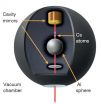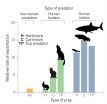RI Hospital researchers: US hospitals flout CDC recommendations that prevent infections
Fewer than half of clinicians surveyed comply with guidelines protecting patients from infections associated with arterial catheters
2015-08-20
(Press-News.org) According to a survey conducted by Rhode Island Hospital researchers, there is significant variability regarding how clinicians manage catheters placed in the arteries of patients in intensive care units. Some practices may increase risk of infection associated with these catheters. Fewer than half of those surveyed complied with current Centers for Disease Control and Prevention (CDC) infection prevention guidelines for arterial catheter insertions. The study was published today in Critical Care Medicine.
"Barrier precautions are employed inconsistently by critical care clinicians across the nation, and such individuals underestimate the infection risks posed by arterial catheters," said Leonard A. Mermel, D.O., ScM, medical director of the epidemiology and infection control department at Rhode Island Hospital and co-author of the study. "Every effort should be made to prevent such infections since they lead to increased cost, length of stay, and morbidity."
In 2011 the CDC published recommendations specifying that clinicians don sterile gloves, a surgical cap and surgical mask, and use a small sterile drape when these catheters are inserted into the artery of a patient. Of the 1,265 study respondents, only 44 percent reported using the CDC-recommended barrier precautions during insertion and only 15 percent reported using full barrier protections.
"There appears to be a significant deviation from clinical guidelines regarding a very commonly performed procedure in critically ill patients," said Andrew Levinson, M.D., MPH, corresponding author. "Bloodstream infections are largely preventable, and if the survey results mirror the clinical practice in the U.S., there's work to be done in reducing risk of such infections."
The responses were anonymous. Survey participants consisted of members of the Society of Critical Care Medicine, specifically attending physicians, fellows, residents, nurse practitioners, physician assistants, registered nurses and respiratory therapists.
All Lifespan hospitals are fully compliant with the CDC's recommendations. They include Rhode Island Hospital and its pediatric facility, Hasbro Children's Hospital; The Miriam Hospital; and Newport Hospital.
The catheter is commonly used in intensive care medicine and anesthesia to monitor the blood pressure and sample blood gasses directly from the artery. Approximately eight million arterial catheters are placed in U.S. hospitals every year. This type of catheter is a potential source of bloodstream infections because it provides a direct, indwelling, and frequently accessed pathway between the skin and bloodstream.
INFORMATION:
There was no outside funding for this study. Andrew Levinson's and Leonard Mermel's principal affiliation is Rhode Island Hospital, a member hospital of the Lifespan health system in Rhode Island. They also have academic appointments at Alpert Medical School of Brown University. Other Lifespan researchers contributing to the study were: David M. Cohen, M.D., Gerardo P. Carino, M.D. Ph.D., Daithi S. Hefferman, M.D., Stephanie N. Lueckel M.D., Dorothy Skierkowski M.A., Jason T. Machan Ph.D. and Jeffrey Mazer M.D., who is now affiliated with Lovelace Medical Group , Albuquerque, N.M.
About Rhode Island Hospital
Founded in 1863, Rhode Island Hospital in Providence, R.I., is a private, not-for-profit hospital and is the principal teaching hospital of The Warren Alpert Medical School of Brown University. A major trauma center for southeastern New England, the hospital is dedicated to being on the cutting edge of medicine and research. Last year, Rhode Island Hospital received more than $50 million in external research funding. It is also home to Hasbro Children's Hospital, the state's only facility dedicated to pediatric care. For more information on Rhode Island Hospital, visit http://www.rhodeislandhospital.org, follow us on Twitter @RIHospital or like us on Facebook http://www.facebook.com/rhodeislandhospitalpage.
ELSE PRESS RELEASES FROM THIS DATE:
2015-08-20
Washington, DC - August 20, 2015 - Swedish exchange students who studied in India and in central Africa returned from their sojourns with an increased diversity of antibiotic resistance genes in their gut microbiomes. The research is published 10 August in Antimicrobial Agents and Chemotherapy, a journal of the American Society for Microbiology.
In the study, the investigators found a 2.6-fold increase in genes encoding resistance to sulfonamide, a 7.7-fold increase in trimethoprim resistance genes, and a 2.6-fold increase in resistance to beta-lactams, all of this without ...
2015-08-20
PHOENIX, Ariz. -- Aug. 20, 2015 -- A study by the Translational Genomics Research Institute (TGen) and other major research institutes, found a new set of genes that can indicate improved survival after surgery for patients with pancreatic cancer. The study also showed that detection of circulating tumor DNA in the blood could provide an early indication of tumor recurrence.
In conjunction with the Stand Up To Cancer (SU2C) Pancreatic Cancer Dream Team, the study was published in the prestigious scientific journal Nature Communications.
Using whole-exome sequencing ...
2015-08-20
If dark energy is hiding in our midst in the form of hypothetical particles called "chameleons," Holger Müller and his team at the University of California, Berkeley, plan to flush them out.
The results of an experiment reported in this week's issue of Science narrows the search for chameleons a thousand times compared to previous tests, and Müller, an assistant professor of physics, hopes that his next experiment will either expose chameleons or similar ultralight particles as the real dark energy, or prove they were a will-o'-the-wisp after all.
Dark energy ...
2015-08-20
Management of boreal forests needs greater attention from international policy, argued forestry experts from the International Institute for Applied Systems Analysis (IIASA), Natural Resources Canada, and the University of Helsinki in Finland in a new article published this week in the journal Science. The article, which reviews recent research in the field, is part of a special issue on forests released in advance of the World Forestry Congress in September.
"Boreal forests have the potential to hit a tipping point this century," says IIASA Ecosystems Services and Management ...
2015-08-20
This news release is available in Japanese.
Humans are just one of many predators in this world, but a new study highlights how their intense tendency to target and kill adult prey, as well as other carnivores, sets them distinctly apart from other predators. As humans kill other species in their reproductive prime, there can be profound implications -- including widespread extinction and restructuring of food webs and ecosystems--in both terrestrial and marine systems. To evaluate the nature of human predation compared to nonhuman predation, Chris Darimont et al. conducted ...
2015-08-20
This news release is available in Japanese.
In this special issue, the editors of Science invite experts to provide closer looks at how natural and human-induced environmental changes are affecting forests around the world, from the luscious, diverse forests of the tropics, to the pristine, resilient boreal forests of the north. The special issue is complemented by a package from Science's news department.
Amid extreme environmental and climate changes, Susan Trumbore and colleagues highlight the urgency of monitoring forest health, especially ...
2015-08-20
This news release is available in Japanese.
Amid continued difficulties around assessing bioweapons threats, especially given limited empirical data, Crystal Boddie and colleagues took another route to gauge their danger: the collective judgment of multiple experts. The experts' opinions on bioweapons-related risks were quite diverse, the Policy Forum authors say, adding to the challenge around developing a regulatory system for legitimate dual use research. Boddie et al. explain how they employed a Delphi Method study to query the beliefs and opinions of 59 experts ...
2015-08-20
An examination of the immune genes of the southern African Khoe-San people has revealed a completely new kind of mutation, according to researchers at the Stanford University School of Medicine. The gene variant likely contributes to healthier babies, although the variant can also lower resistance to disease.
The findings grew out of a long-term effort by Peter Parham, PhD, professor of structural biology and of microbiology and immunology, to understand how immune system genes make us reject organ transplants.
A paper detailing the findings will be published online ...
2015-08-20
CORVALLIS, Ore. - Myriad regulations and certification requirements around the world are making it virtually impossible to use genetically engineered trees to combat catastrophic forest threats, according to a new policy analysis published this week in the journal Science.
In the United States, the time is ripe to consider regulatory changes, the authors say, because the federal government recently initiated an update of the overarching Coordinated Framework for the Regulation of Biotechnology, which governs use of genetic engineering.
North American forests are suffering ...
2015-08-20
Are humans unsustainable 'super predators'?
Want to see what science now calls the world's "super predator"? Look in the mirror.
Research published today in the journal Science by a team led by Dr. Chris Darimont, the Hakai-Raincoast professor of geography at the University of Victoria, reveals new insight behind widespread wildlife extinctions, shrinking fish sizes and disruptions to global food chains.
"These are extreme outcomes that non-human predators seldom impose," Darimont's team writes in the article titled "The Unique Ecology of Human Predators."
"Our ...
LAST 30 PRESS RELEASES:
[Press-News.org] RI Hospital researchers: US hospitals flout CDC recommendations that prevent infections
Fewer than half of clinicians surveyed comply with guidelines protecting patients from infections associated with arterial catheters



